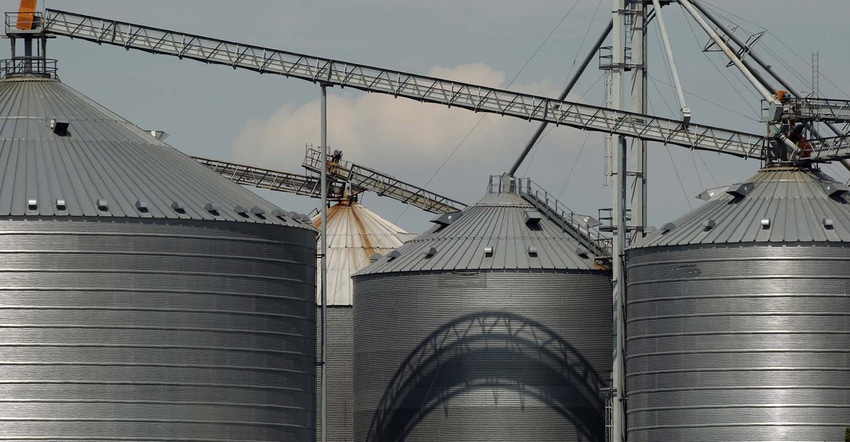
Barring a sudden turnaround in prices headed into harvest, growers likely will be faced with the challenge of what to do with all those corn and soybeans coming off the combine. Most of the grain will be headed into storage, either on the farm or in town in the hope that prices will rise after those bin doors shut tight. But before sealing your crops, take time to remember a simple fact: Long-term storage of corn and soybeans is a gamble.
To be sure, if you roll the dice every year, you’ll make money. Our study of storage strategies dating all the way back to 1985 shows holding soybeans on farm until summer earned a better price than at harvest 70% of the time. Annual gains averaged 79 cents a bushel over those 33 years.
Gains for corn averaged 22 cents but had lower odds of success. Storing corn on farm made money just 17 of the last 33 years.
In other words, there’s almost an equal chance of making or losing money with corn. Livestock producers can’t store their production, hence the adage “sell it or smell it.” Unfortunately, the same can be true with corn many years. Some years, prices just stink.
Growers willing to limit upside potential can improve their chances a little. Though holding cash corn and soybeans on farm is the most successful strategy over time, the storage hedge for corn has the best odds of beating the harvest price. This involves selling deferred futures/or hedge-to-arrive contracts at harvest for delivery in July to benefit from strengthening basis regardless of what flat prices do. Still, average gains from the storage hedge of 10 cents a bushel are less than half those from holding corn on farm.
Our study also looks at other ways farmers can store, from using bins in town to options and futures strategies, most of which involve storing crops on paper rather than retaining ownership. But is there a way to improve your crystal ball for making a decision on which strategy to use?
One variable we found correlated with profitability takes clairvoyance of its own. Analysts use the ratio of corn usage to ending stocks to measure supply and demand, and ultimately, prices. In years when this ratio tightened from harvest to summer, owning corn, either in the bin or on paper using futures or call options, tended to do better. Conversely, when supply and demand weakened, storing corn tended to do worse. So, if USDA’s estimates this fall seem too bearish, storage may indeed pay off – if your forecast is better than the government’s.
The other factor associated with storage profitability takes a little less guesswork: basis, the difference between cash and futures. In this case we looked at cash against deferred July futures, which not only includes nearby basis but carry, the spread between December and July contracts. Wider basis improved potential for storage hedges, or for buying a put option to protect the downside on stored inventory.
But in years with a bearish twist – or times with a “black swan” event like trade disputes – even these two variables didn’t work. Storing cash corn on average at the nine locations we studied earned a penny per bushel, not including the cost of bins, drying and shrink. And the storage hedge with futures or puts did worse than the harvest prices, even before those other costs.
That’s the real message of our study: Nothing works every year. If you decide to store grain and see prices rise, don’t want until summer to pull the trigger.
Here are complete year-by-year results and summaries for the locations studied from the 1985 to 2017 marketing years.
http://farmfutures.com/sites/farmfutures.com/files/YearByYearResultsTable.pdf
http://farmfutures.com/sites/farmfutures.com/files/090618Toledo.pdf
http://farmfutures.com/sites/farmfutures.com/files/090618Omaha.pdf
http://farmfutures.com/sites/farmfutures.com/files/090618NorthCentralIowa.pdf
http://farmfutures.com/sites/farmfutures.com/files/090618Minneapolis.pdf
http://farmfutures.com/sites/farmfutures.com/files/090618KansasCity.pdf
http://farmfutures.com/sites/farmfutures.com/files/090618EvansvilleCornLouisvilleSoybeans.pdf
http://farmfutures.com/sites/farmfutures.com/files/090618DenverCorn.pdf
http://farmfutures.com/sites/farmfutures.com/files/090618CentralIndiana.pdf
http://farmfutures.com/sites/farmfutures.com/files/090618CentralIllinois.pdf
http://farmfutures.com/sites/farmfutures.com/files/090618LongTermAverageReturns2017.pdf
http://farmfutures.com/sites/farmfutures.com/files/090618AverageReturns2001-2017.pdf
About the Author(s)
You May Also Like




